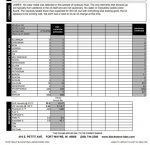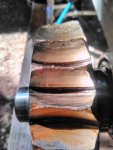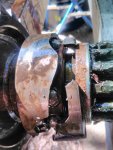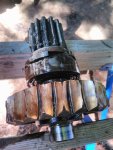KN6KXR
Well-known member
- 270
- 647
- 93
- Location
- Felton, CA
OK well had some more time today to play. Got stuff done found stuff out. Here's what I found:
1) After settling overnight I pulled about 3 gallons of oil out of the tank into a bucket. It's a caramel color so there's stuff in it. No water though. I let that settle in the bucket for a few hours before pouring it back in. Leftover in the bucket was fine sediment like charcoal just a tiny bit. I'll need to figure out a rehab for the tank or PM schedule to keep the oil super clean. I'm thinking a pump to a filter and back in the fill. For now it's OK.
2) I then adapted my hydraulic pressure gauge to the valve block as instructed in the TM. The plug is 1/8" so I used a 1/8" to 1/4" adapter. At a later time I think I'm going to install an elbow, shutoff and quick disconnect with plug. Just like my tractor so I can make sure it's correct without taking the whole thing apart. Some oil came out but if you are ready for it a blue towel got it up so not a lot. Truck likes to be oily anyways. So @gstirling nothing too crazy here.
3) Found the TM for this is more or less completely wrong. One I'm referring to is the one I posted above. Fact is there is no pressure to set a relief unless a valve is actuated and the system is two-blocked to lift the relief and adjust. The TM says 1250 rpm and this is OK because the pressure is OK there but the speed isn't. Especially with no load. I tried different rpm and settled at 1700 because that's design. I then found the current setting about 2100-2200 psi. To do this I used the boom all the way up (try to keep going it lifts the relief) and the boom retracted (keep retracting it lifts the relief) and both. I played with the range and there's no way 1350 psi is going to work. Not even close. So I recall Wes saying something about 2200psi unless you replace hoses. I noted my hoses are labeled 2400 psi. So I set it at 2200. The relief tops out about there you can go higher but it takes more turns you know your at the limits. Maybe Wes @simp5782 will chime in about this.
4) I then left my gauge on there and tried my test object. My test object is my MQ DCA25 generator and it weighs about 2800 pounds. During this test I tried low (1300) and high (1900) rpm ranges. When throttling up I noted the transmission shift (I assume from the kick down) and it was about 1700rpm so @Jaydog996 you're onto something there. It was the same story as before: lift, extend, boom all good rotate NFG. The rotation left direction, when it does, runs the gauge up to 1500 then breaks free and jerks. Going right if you're gentle you'll just flat out go to 2200 psi and ride the relief with no motion. If you jerk it then it'll break free (at 1900 rpm but not at 1500) but once again it jerky and not controllable.
5) I then checked it all out at 1900 rpm unladen again and it works great. Pressure gets up to maybe 500psi rotating but turns smooth and controllable.
So with that I'm looking to the rotator table hydraulic motor, gear alignment, some type of binding under load? Seems like a big job. I think the pump, filter, fluid, relief, valve block, hoist (only 500 psi to lift 3k pounds) all check out. You have any thoughts or pointers please post them up. I'm kinda bummer I have a crane that can lift but not rotate a load......
1) After settling overnight I pulled about 3 gallons of oil out of the tank into a bucket. It's a caramel color so there's stuff in it. No water though. I let that settle in the bucket for a few hours before pouring it back in. Leftover in the bucket was fine sediment like charcoal just a tiny bit. I'll need to figure out a rehab for the tank or PM schedule to keep the oil super clean. I'm thinking a pump to a filter and back in the fill. For now it's OK.
2) I then adapted my hydraulic pressure gauge to the valve block as instructed in the TM. The plug is 1/8" so I used a 1/8" to 1/4" adapter. At a later time I think I'm going to install an elbow, shutoff and quick disconnect with plug. Just like my tractor so I can make sure it's correct without taking the whole thing apart. Some oil came out but if you are ready for it a blue towel got it up so not a lot. Truck likes to be oily anyways. So @gstirling nothing too crazy here.
3) Found the TM for this is more or less completely wrong. One I'm referring to is the one I posted above. Fact is there is no pressure to set a relief unless a valve is actuated and the system is two-blocked to lift the relief and adjust. The TM says 1250 rpm and this is OK because the pressure is OK there but the speed isn't. Especially with no load. I tried different rpm and settled at 1700 because that's design. I then found the current setting about 2100-2200 psi. To do this I used the boom all the way up (try to keep going it lifts the relief) and the boom retracted (keep retracting it lifts the relief) and both. I played with the range and there's no way 1350 psi is going to work. Not even close. So I recall Wes saying something about 2200psi unless you replace hoses. I noted my hoses are labeled 2400 psi. So I set it at 2200. The relief tops out about there you can go higher but it takes more turns you know your at the limits. Maybe Wes @simp5782 will chime in about this.
4) I then left my gauge on there and tried my test object. My test object is my MQ DCA25 generator and it weighs about 2800 pounds. During this test I tried low (1300) and high (1900) rpm ranges. When throttling up I noted the transmission shift (I assume from the kick down) and it was about 1700rpm so @Jaydog996 you're onto something there. It was the same story as before: lift, extend, boom all good rotate NFG. The rotation left direction, when it does, runs the gauge up to 1500 then breaks free and jerks. Going right if you're gentle you'll just flat out go to 2200 psi and ride the relief with no motion. If you jerk it then it'll break free (at 1900 rpm but not at 1500) but once again it jerky and not controllable.
5) I then checked it all out at 1900 rpm unladen again and it works great. Pressure gets up to maybe 500psi rotating but turns smooth and controllable.
So with that I'm looking to the rotator table hydraulic motor, gear alignment, some type of binding under load? Seems like a big job. I think the pump, filter, fluid, relief, valve block, hoist (only 500 psi to lift 3k pounds) all check out. You have any thoughts or pointers please post them up. I'm kinda bummer I have a crane that can lift but not rotate a load......






